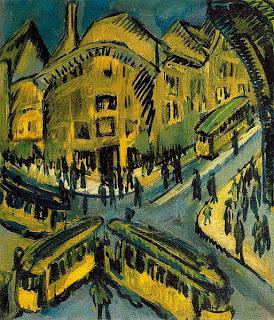30 Mart 2012 Cuma
EXPRESSIONISM
-Expressionism, was a modernist movement, initially in poetry and painting, originating in Germany at the beginning of the 20th century.
-Expressionism was developed as an avant-garde style before the First World War. It remained popular during the Weimar Republic, particularly in Berlin
-The term is sometimes suggestive of emotional angst. In a general sense, painters such as Matthias Grünewald and El Greco are sometimes termed expressionist, though in practice the term is applied mainly to 20th-century works.
-While the word expressionist was used in the modern sense as early as 1850, its origin is sometimes traced to paintings exhibited in 1901 in Paris by an obscure artist Julien-Auguste Hervé, which he called Expressionismes
August Macke
Ernst Ludwig Kirscher
Franz March
24 Mart 2012 Cumartesi
LES NABİS
(1891-1899)
- REPRESENTER: Pierre Bonnard, Ker Xavier Roussel, Felix Vallotton, Maurice Denis, Edouard Vuillard, Maxime Dethomas, Meyer de Haan, Rene Geoeges Hermann- Paul, Henri- Gabriel Ibels, George Lacombe, Aristde Maillol, Paul Ranson, Jozsef Rippl-Ronai, Paul Serusier, Felix Vallotton, Jan Verkade and Edouard Vuillard.
- Les Nabis were a group of Post-Impressionist artists and illustrators in Paris who became very influential in the field of graphic art in France in the 1890s.
- Most of grup members studied at the private school of Rodolpe Julian in Paris in the late 18880.
- Their emphasis on design was shared by the parallel Art Nouveau movement. Both groups also had close ties to the Symbolist painters.
- Les Nabis originated as a rebellious group of young student artists who banded together at the Académie Julian
- Les Nabis regarded themselves as initiates, and used a private vocabulary. They called a studio ergasterium, and ended their letters with the initials E.T.P.M.V. et M.P., meaning "En ta paume, mon verbe et ma pensée" ("In the palm of your hand, my word and my thoughts.")
- Les Nabis artists worked in a variety of media, using oils on both canvas and cardboard, distemper on canvas and wall decoration, and also produced posters, prints, book illustration, textiles and furniture.
- The artists of this circle were highly influenced by the paintings of the impressionists, and thus while sharing the flatness, page layout and negative space of art nouveau and other decorative modes, much of Nabis art has a painterly, non-realistic look, with color palettes often reminding one of Cézanne and Gauguin.
- After the turn of the century, as modern art moved towards abstraction, expressionism, cubism, etc., the Nabis were viewed as conservatives, and indeed were among the last group of artists to stick to the roots and artistic ambitions of the impressionists, pursuing these ends almost into the middle of the 20th century. In their later years, these painters also largely abandoned their earlier interests in decorative and applied arts.
Fellix Vallatton
The Mistress and Servant
(1896)
Pierre Bonnard
The Dining room in the Country
(1913)
Meyer de Haan
Maternity : Mary Henry Breastfeeding
(1890)
Maternity : Mary Henry Breastfeeding
(1890)
9 Mart 2012 Cuma
SYMBOLISM
- Symbolism originated in France and it was part of a 19th century movement in which art became infused with mysticism.
-Thematically, the art of Symbolism developed as a countercurrent to Impressionism and the various forms of Naturalism.
- The term of symbolism means the systematic use of symbols or pictorial conventions to expres an allegorical meaning.
-The symbolist painters used these sybols from mytholugy and dream imagery for a visual language of the soul.
- Gustave Moreau's painting:
-Thematically, the art of Symbolism developed as a countercurrent to Impressionism and the various forms of Naturalism.
- The term of symbolism means the systematic use of symbols or pictorial conventions to expres an allegorical meaning.
-The symbolist painters used these sybols from mytholugy and dream imagery for a visual language of the soul.
- Gustave Moreau's painting:
NEO-IMPRESSIONISM
Representative artist: Julian Schnabel, David Salle, Francesco Clemente, Sandro Chia, Anselm Kiefer, Georg Baselitz
-Neo-expressionism is a style of modern painting and sculpture that emerged in the late 1970s and dominated the art market until the mid-1980s.
- Neo-Expressionism comprised a varied assemblage of young artists who had returned to portraying the human body and other recognizable objects, in reaction to the remote, introverted, highly intellectualized abstract art production of the 1970s.
Neo-Expressionist paintings themselves presented certain common traits.
-Among these were: a rejection of traditional standards of composition and design; an ambivalent and often brittle emotional tone that reflected contemporary urban life and values; a general lack of concern for pictorial idealization
-Georg Baselitz
-Georges Seurat
IMPRESSIONISM
(19th century art movement)
Claude Monet
This art movement originated with a group of Paris-based artist
Representative: Claude Monet , Pierre Auguste Renoir, Camille Pissarro, Alfred Sisley,Edgar Degas, Paul Cezanne, Berthe Morisot, Armand Guillaum and Frederic Bazille
- Impressionism a major movement, first in painting and later in music
- This art movement developed chiefly in france during the late 19th and early 20th centuries.
- Impressionist painting comprises the work produced between about 1867 and 1886 by a group of artists who shared a set of related approaches and techniques.
- The most conspicuous characteristic of Impressionism was an attempt to accurately and objectively record visual reality in terms of transient effects of light and colour.
- The established painter is Eduard Manet.
- Impressionist painters worked together, influenced each other, and exhibited together independently.
- Many sample of the impressionist style of painting:
Albert Gustav Aristides
 |
Kaydol:
Kayıtlar (Atom)









